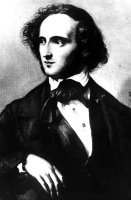Fingal's Cave - an organ in stone - a natural cathedral




A sea cave on the uninhabited island of Staffa in the Inner Hebrides of Scotland, Fingal’s Cave gave its name to one of Felix Mendelssohn’s most well known works; The Hebridean Overture.
Mendelssohn visited Scotland in 1829 and wrote the overture a year later, and published it in 1835. It received its first performance by the London Philharmonic Society and was roundly applauded.
Mendellssohn was attracted to the cave, formed of hexagonal basalt, part of the ancient lava flow that was reponsible for Giant’s Causeway in Northern Ireland. The eerie sounds produced by waves gave it the atmosphere of a natural cathedral, it was said.
Mendelssohn was rowed to it in a small boat with his friend, Carl Klingemann, who said, "Its many pillars made it look like the inside of an immense organ, black and resounding, absolutely without purpose, and quite alone, the wide grey sea within and without." Mendelssohn was apparently inspired by the strange echoes in the cave, as well as by its organ like appearance.
Fingal was the name of Fionn mac Cumhail, the hero of a poem by James Macpherson the 18th Century Scots poet-historian and earlier immortalized by the poet Ossian. The cave itself was discovered by the naturalist, Sir Joseph Banks in 1772.
The overture is now an essential piece in any orchestra’s repertoire and is played regularly and often in concert halls all over the world.
http://www.redwoodsymphony.org/history/prognotes.aspx?ID=393
Robert L. Fielding

0 Comments:
Post a Comment
Visit My Website<< Home